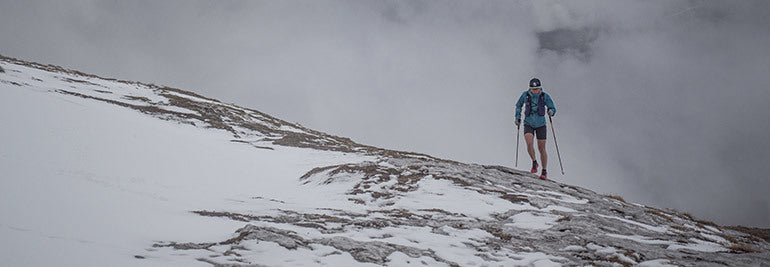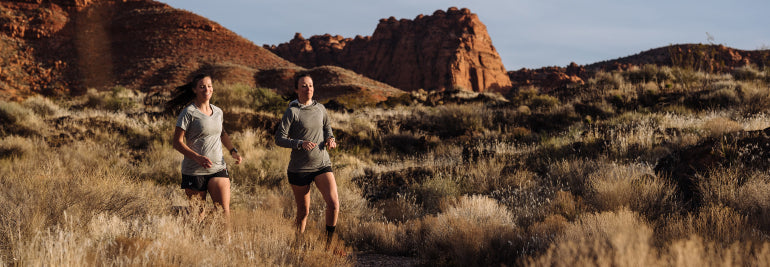

Suunto Blog

9 rules to follow when your trip in the mountains goes pear-shaped
Spend enough time in the mountains and you learn to expect the unexpected. You might start out in delightfully warm weather and then, surprise, a storm arrives and covers the landscape in snow. Didn’t see that coming!
In the second article in this series on wayfinding, we talked about how to plan a route in the mountains. In the third article, we explained how to stay on track when you’re out on a trip. In this article we look at how to react when conditions get difficult.
Thing is, even the best laid plans can and probably will go awry. It’s important to understand your plan is just a plan. The world around you marches to its own drumbeat.
Photo by Tim Tiedemann on Unsplash
3 general rules
Be responsive
Our resident navigator-in-chief Terho Lahtinen advises to expect the unexpected. You don’t want to get too vigilant and uptight, however, because then nothing is much fun. Just keep it in the back of your mind that things can change, and to be responsive when they do.
Terho says to cultivate this quality it’s good to go through different scenarios in advance of the trip and to have plans for each of them.
“In the mountains, you should always have a plan B for surprises: a shorter route, extra clothing, first aid kit, backup navigation device, and so on,” he says. “Having the right equipment and skills to use them properly is the best preparation.”
Stay calm
Goes without saying, but when things take a turn for the unexpected it’s important not to panic. Panic impairs our decision making ability, which can be a big deal in the backcountry. Instead, do something to help you relax.
“When you encounter an unwanted situation, make a stop, have a snack, find shelter if possible and put on an extra layer to keep warm,” Terho says. “It’s more important to make the right decision rather than a quick one that turns out wrong.”
Consider all options
Once you’ve settled down, consider all your options. Talk with your group and see how everyone is feeling. What options suit the skill level and comfort zone of your group?
“Sometimes the conditions are just not on your side and the only reasonable plan B is to postpone the trip,” Terho says. “This can be a very hard decision if it’s a long-awaited adventure, but it’s better to be safe than sorry.”
This is when a Suunto 9 comes in handy. The watch’s Find Back function guides you directly back to your starting point via a breadcrumb trail on the watch face. You can also store Points of Interest on the go and navigate back to them.
Photo by asoggetti on Unsplash
Specific rules for low visibility
One typical thing that can catch people out in the mountains is poor visibility, whether caused by fog, rain, snow or low light. You have to pay extra attention in any of these conditions, and really consider what options are the best for you and the group.
Easy does it
In low visibility always choose the easiest route to follow. Stay on a marked trail instead of taking an off track shortcut.
“If there are no trails, use obvious terrain features as checkpoints that you are sure to recognize,” Terho says.
Know your location
One of the ways people get into trouble in the mountains is by pushing on hastily without being sure about their location. In low visibility, take the time to regularly check in with your map.
“If you lose your location on the map, it is much more difficult to find it again if you can’t see your surroundings,” Terho says. “In practice, you will need to pay attention to all details in the terrain that you can identify on the map, and also work through the terrain features that you expect to see when moving on.”
Keep track of time
Monitoring your travel time is essential to estimate the distance you have traveled. This is important because in low visibility it will help you estimate where you likely are on the map.
“It’s worth noting that in poor visibility we tend to overestimate the distance traveled and the pace often gets slower when visibility drops,” Terho says. “When trying to spot yourself on the map, remembering this limits the radius of where to look on the map.”
A stream can act as a handrail to lead you to the next terrain feature. Photo by Hamed Alayoub on Unsplash
Follow handrails
We talked about using handrails as navigation aids in the previous article in this series. They can be particularly useful in low visibility, even as reassurance.
“A good handrail is a clear terrain feature that you can easily follow, such as a creek, river, hillside, a fence or the treeline,” Terho explains. “Sometimes you can also use the elevation of the handrail as an additional navigation aid.”
Use all your tools
When you’re way out in the backcountry far from help or above the treeline and exposed to the elements, time is of the essence. Cold is the enemy. Use all your tools to help you stay on track and safe. Your compass, watch, altimeter, GPS device – each one can help you.
“Use your compass to check the trail you’re on goes in the right direction,” Terho says. “Check the time every now and then; knowing your average pace and the time in the last known location helps to estimate how far you could have traveled. An altimeter is also a practical tool. For instance, working out your location on a trail that goes up or down a slope can be done with an altitude reading. As a backup, it’s also good to have a GPS like a Suunto 9 watch with the most important waypoints and the planned route stored.”
Wait it out
Sometimes the best thing you can do is to find shelter asap. Especially in cold conditions, staying warm is the priority. Hypothermia, when your body loses heat faster than it can produce it, can set in within minutes to hours, depending on the temperature.
“There are times when the best option is to pitch camp, sleep over and evaluate the options again next morning,” Terho says.
Lead image: Photo by Philipp Reiter
Read more articles
How to find your way in the mountains
7 tips to plan a route in the mountains
A veteran navigator's 9 tips to stay on track in the mountains

Don’t get sucked into the black hole
There’s a training pattern that eats away your improvements. Suunto partner PerfectPace explains the black hole and how to avoid it.
Many of us know this scenario: your training plan has you scheduled for an easy recovery run that mysteriously becomes faster and faster. Maybe it’s because you are motivated and feel good or because you don’t want to be overtaken by that runner just behind you. Sounds innocent enough, right? Thing is, running just a bit faster than you are supposed to can destroy your training program without you or your trainer even realizing it. You were just sucked into the training black hole.
For serious training blocks, don't fall into the middle of the black hole.
What is the black hole?
Stephen Seiler, an American sport scientist at the University of Adger in Kristianstad, Norway, researched this phenomenon in 2007 and gave it the name, “training in the black hole”. The black hole consists of an alluring, gratifying training intensity and sucks your training into it. Your easy runs become a bit faster and the hurtful high intensity intervals become a bit less intense. Instead you drift down the middle into the gaping maul of the black hole. You don’t train one or the other intensity you are supposed to. Training on recovery days becomes just a bit too intense to give your best on high intensity training days.
For non professionals training in the black hole might be somewhat ok. You go for a 30-60 minute run and you run a bit faster than you should. Until your next training two days might pass which is enough time to fully recover. The intensity will be high enough for adaptations. For serious training, however, it’s essential to train in low and high intensity zones and not in the black hole.
The black hole in elite sports
The reason for Seiler researching the phenomenon of the black hole arose out of an experience with Olaf Tufte, an elite Norwegian rower. After winning third place at the world championships in 2002 Olaf had mediocre results in races the year after. The cause of the disappointing results was a mystery, especially given his training schedule did not change. Eventually he and his trainers discovered the cause: the cool new boat he got after the championships in 2002 gave him the extra motivation to go faster than normal on his recovery days. This additional intensity was enough to sabotage his regeneration and his results. He’s been pulled into the black hole.
Avoiding the back hole: know your intensity
There is a simple way to avoid being pulled into the black hole; don’t train according to feeling and whim, but have a proper training plan and be mindful of which training zone you should be in on each workout and stay in it. To be precise about these training zones and the levels of intensity, you need to know your heart rate, pace or power zones. Click here to read more about understanding your training zones. And handily, Suunto watches display in real-time which training zone you are in on the watch face. They also show the duration you spent in each zone and allow you to set an intensity target for each workout.
PerfectPace is the endurance training platform for triathletes that takes you a step ahead. For a steady performance gain you had to know a lot about training methodology to plan your training sessions. Especially in a sport like triathlon where three sports need to be planned correctly. This is where PerfectPace steps in. It offers not only unique statistics that up to now were only available in expensive desktop applications but it also helps to create a plan that boosts your performance with the help of artificial intelligence, big data and the latest advances in training science. PerfectPace considers not only your training activities but also rest days, tapering, even injury and your personal strengths and weaknesses.
Lead images:
© Graeme Murray/Red Bull Content Pool
Read more articles
Know your resting and max heart rates
10 reasons to enjoy open water swimming with Suunto
The benefits of training to music and making your best playlist

Running books to read on your summer vacation
Summer holidays are a time to rest and recharge, and also an opportunity to reignite our inspiration. Whether you’re having a "staycation", on a multi-day hiking trip in the mountains, sunbathing at the beach or on a family road trip, take along one of these six books about running and you will get yourself motivated for your training in the second half of the year.
1. Above the Clouds: How I carved my own path to the top of the world.
Two-time National Geographic Adventurer of the Year and Suunto ambassador Kilian Jorney has broken mountaineering records all over the world. Kilian Jornet's new book, Above the Clouds, recounts his life of studying and ascending the greatest peaks on earth. Kilian reveals his process and on what he has found in nature—simplicity, freedom, and spiritual joy.
2. Sky Runner: Finding Strength, Happiness, And Balance In Your Running, by Emelie Forsberg
Suunto ambassador and four-time back-to-back Skyrunner World Series champion Emelie Forsberg lives for the outdoors. It’s part of everything the Swedish running phenomena does. In this book, she shares her passion for mountain running and expert insights into this demanding sport. Buy it here.
3. Trail Blazer: My Life as an Ultra-distance Runner, by Ryan Sandes
Ryan Sandes has run ultras in some incredible places: Antarctica, the Sahara and the Gobi deserts, and recently set a fastest known time record on the Great Himalayan Trail. In his usual easy-going and down-to-earth style, he tells his incredible story. Buy it here.
4. Training Essentials for Ultrarunning: How to Train Smarter, Race Faster, and Maximize Your Ultramarathon Performance, Jason Koop
If you’re looking for a challenge in the second half of your year, how about running an ultra marathon? If you’re called to the challenge, then this training book by ultra running coach to elite athletes Jason “Coach” Koop is a must have. Reading it will set up your training programme. But it here.
5. The Way of the Runner: A Journey into the Fabled World of Japanese Running, by Adharanand Finn
You might be as surprised as we were to discover that Japan is the most running obsessed nation on Earth. Author, journalist and runner, Adharanand Finn has followed up on his first book – Running with the Kenyans: Discovering the Secrets of the Fastest People on Earth – with another book that delves into Japan’s one-of-a-kind running culture and what it might teach us about the sport and about Japan. Buy it here.
6. Run or Die, by Kilian Jornet
When it comes to running, Kilian Jornet is a different kind of beast; ski mountaineering, vertical races, ultra marathons, mountaineering, fastest known time records – he is king of all. In 2017, he made two lightning speed ascents of Everest in a single week, completing his Summits of my Life project. This is a classic written by a super athlete. Buy it here.
Lead image: © Photo by Toa Heftiba on Unsplash
Know your resting and max heart rate
Keeping track of your heart rate is vital for endurance athletes. In this article Suunto partner PerfectPace explains the ins and outs.
Knowing your max heart rate is an important guide for athletes. It gives you a roof for your training and indicates the level of intensity. On the other hand, one of the first signs of overtraining syndrome is an elevated resting heart rate. For endurance athletes doing high volume training this is essential to watch out for.
Identifying your maximum and resting heart rate is vital for the calculation of training zones. Particularly for endurance training these numbers are very important and they are not hard to come to. But there are a few things to consider.
Source: Age-predicted maximal heart rate in healthy subjects: The HUNT Fitness Study
How to find your maximum heart rate
You have probably heard of the formula 220 minus age to get your maximum heart rate. Some say that this formula is not too exact but all in all the results are ok. Unfortunately that is not the case. In most cases the result is way off.
A Norwegian study on more than 3300 healthy women and men has tested their maximum heart rate. The graphic below shows the result. What we can see is that the average values for the whole population is on a straight line. But for most individuals their maximum heart rate is far from that line. The conclusion is that the formula works for the average global population but not for an individual.
When looking at the graph it is also evident that no formula can calculate the individual maximum heart rate. The results are just too scattered. The only way to get to your max HR is via a test.
How to test your maximum heart rate
The maximum heart rate should be tested in your sport. Runners should run and swimmers swim. Triathletes should do a run test. The heart rate is the highest in running of all three sports.A max HR test is VERY demanding. You need to go to your limit and that will hurt.
A typical test for runners looks like this:
Warm up for at least 10 minutes. Now increase your tempo for 5 minutes until you get out of breath. This is the time to start a one minute spurt. It will hurt but you need to max out. Depending on your ability to push yourself you’ll get close to your maximum heart rate.
How to find your resting heart rate
Like for the maximum heart rate there is no formula to calculate your resting heart rate. The resting heart rate is even more individual than the maximum heart rate. Some sport watches can measure your pulse while sleeping. In the morning you will have your resting heart rate.
If you don’t have such a device you can simply measure your heart rate right after you woke up. Untrained have a resting heart rate between 60-80 bpm. Endurance athletes might have only 35 bpm. The reason for such differences are adaptations to the cardiovascular system. The heart gets stronger and more efficient when under high load but also when resting.
Changes of the maximum and resting heart rate
The heart rate changes during your lifetime. Simply by getting older. A new born baby has a resting heart rate of 130-140 and it drops with every year. This is the reason why the formula 220 minus age came up. But there are a lot more factors than just age that influence your heart rate all the time. Therefore you should test again from time to time to make sure your training zones match your physiology.
But there are also short term changes in your heart rate. You won’t be able to reach your max heart rate every day. Also the resting HR is changing from day to day up to 15 beats per minute. reasons can be a cold or over training. By checking your resting heart rate regularly you can spot abnormal stress levels early and adapt your training.
PerfectPace is the endurance training platform for triathletes that takes you a step ahead. For a steady performance gain you had to know a lot about training methodology to plan your training sessions. Especially in a sport like triathlon where three sports need to be planned correctly. This is where PerfectPace steps in. It offers not only unique statistics that up to now were only available in expensive desktop applications but it also helps to create a plan that boosts your performance with the help of artificial intelligence, big data and the latest advances in training science. PerfectPace considers not only your training activities but also rest days, tapering, even injury and your personal strengths and weaknesses.
Lead images:
Photo by Brian Erickson on Unsplash
© Kevin Scott Batchelor
Read more articles
10 reasons to enjoy open water swimming with Suunto
The benefits of training to music and making your best playlist

4 tips to recover well for your best performance
The Suunto Summer Challenge on Map My Run this July is all about inspiring you to create a workout routine and sticking to it. One oft ignored component to keep your training steady is ensuring you are getting enough recovery time. It can seem like taking a break from running will disrupt your momentum, but oftentimes it does the exact opposite – it freshens you up and reinvigorates you.
Proper recovery time allows the body to adapt in response to your workouts. It also prevents overtraining syndrome – which can knock out of the game for months if you get it. Our running coach Denise Sauriol – the Marathon Whisperer – is a huge advocate of recovery. She sees it as an essential component in any training block. Below are her four tips to do it well.
To participate in the Suunto Summer Challenge all you need to do is sync your Suunto App with Map My Run, get out training, reach new badge levels and be in to win one of four Suunto 7 GPS smartwatches! Full details here.
© Graeme Murray/Red Bull Content Pool
Take the plunge
Swimming is an incredible workout for the whole body. The weight of your body is carried by the water, allowing muscles to relax. It’s a great form of active recovery. Especially the day after your long run. It helps minimize delayed onset muscle soreness.
Try open water swimming if public pools are closed. And if you really want to energize your system, give cold water swimming a go.
Recovery means downtime
Recovery days are meant to be off days not travelling all over town taking care of errands. Make sure you really get the downtime you need. Consider making your recovery days technology-free, and instead go for a swim, a gentle stroll in the park, or read a book on the couch.
The Suunto 7 smartwatch ‘recovery time’ feature tracks your workouts and gives you an estimation on how long you need to recover from your exercise based on stats like duration and intensity. Recovery is a key element of both your training and overall wellness. Remember, it helps prepare you for adventures to come.
Don’t fight yourself
If you have too many days in a row where it’s a mental and physical fight to get through a workout, I recommend you take two to three days off. By doing this you are giving yourself a “control-alt-delete” reset for your mind and your body. You will see on your next run you will come back stronger because of the extra, unplanned day off.
Check your resting heart rate
A way to test if you are overtraining is to check your resting heart rate when you first wake up. If it is abnormally high, this could be a sign that you should reduce the intensity of your plan over the next few weeks until your heart rate is back to normal.
Tracking your daily heart rate is easy with the Suunto 7 smartwatch.
This is the third and final article in the Suunto Summer Challenge on Map My Run happening throughout July. The challenge is all about creating a workout routine and sticking with it!
Lead images:
© Graeme Murray/Red Bull Content Pool
Read more articles
Welcome to the Suunto Summer Challenge
12 must-read running articles to boost performance
Running books to read on your summer vacation

4 tips to keep your training fresh and effective
To continue to improve your running performance and keep it interesting, varying your training is essential. If you do the same thing day in day out, it’s easy for it to become mechanical, resulting in a loss of motivation. Time to mix it up!
In this second article for our Suunto Summer Challenge on Map My Run, happening this July, our coach Denise Sauriol – The Marathon Whisperer – lays out four tips to keep your runs fun and inspiring!
To participate in the Suunto Summer Challenge all you need to do is sync your Suunto App with Map My Run, get out training, reach new badge levels and be in to win one of four Suunto 7 GPS smartwatches! Full details here.
© Graeme Murray/Red Bull Content Pool
Turn up the intensity
If you want to race at a pace faster than you train, you will have to incorporate higher intensity runs into your training. These speed workouts and tempo runs are what I call “gritervals” because you have to call on some internal grit to get through them. They are performed at a much faster pace than your easy runs.
Even when I coach beginner runners, I slowly incorporate speed workouts into their training plan. One reason is that my runners will see their pace improve sooner and the second reason is the sense of accomplishment they get from doing these types of workouts.
If you're new to speed drills, start very gradually. Here's how: to warm up walk briskly for five minutes, then jog at an easy pace for five minutes, then increase your pace to 50% of your maximum capacity for a minute or two, then shift to running more quickly, like around 80% of your max capacity, for 30 seconds (but don't sprint). Repeat this two or three more times and then warm down.
Cross train
It’s important to incorporate cross training into your training routine as it not only mixes things up, so you are less likely to get bored, but it also helps make you a stronger more balanced athlete.
By cross training, you will be working more muscles than just those running strengthens. Since our most valuable commodity is our time, why not choose two of the most effective cross training exercises, swimming and rowing? They both target all your muscle groups in one shot!
Build mental toughness
Adding high intensity workouts doesn’t just help us physically, but I believe they also indirectly improve our mental endurance. Again, this is because we must dig deeper to get through them compared to our easy runs. We are making the manageably-uncomfortable, comfortable!
This is important because our mental endurance is what we call on in the latter part of our races when the legs may want to quit, but the mind will push on bravely. One great way to build mental toughness is to incorporate hill training repetitions.
Run mindfully
Out on your runs, practice being guided by your senses. Once in a while leave your watch and phone at home. Run and really listen to your foot strike, feel your breathing, the wind and elements on your face and body.
Try this presence exercise: touch your index finger to your thumb on each hand in time with your in and out breath. Consciously, look around at what you are experiencing rather than only worrying about time, pace or your heart rate zone.
This is the second article in the Suunto Summer Challenge on Map My Run this July. The challenge is all about creating a workout routine and sticking with it!
Lead images:
© Graeme Murray/Red Bull Content Pool
© Damien Rosso / Red Bull Content Pool














































































